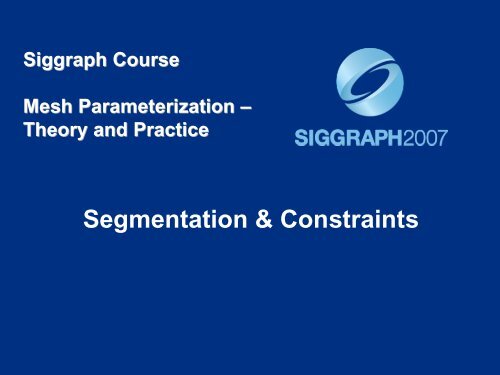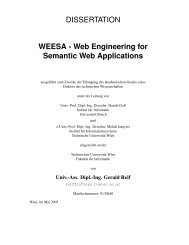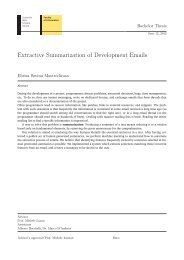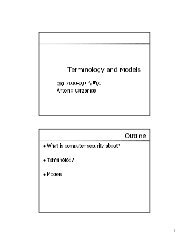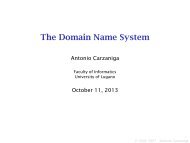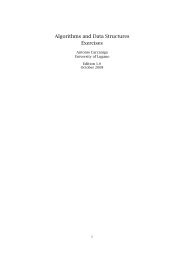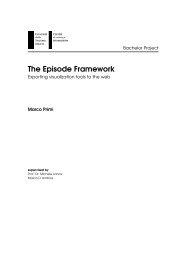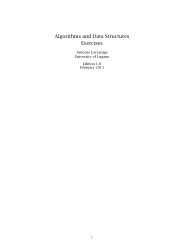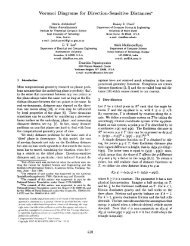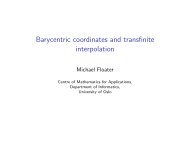Segmentation & Constraints
Segmentation & Constraints
Segmentation & Constraints
Create successful ePaper yourself
Turn your PDF publications into a flip-book with our unique Google optimized e-Paper software.
Siggraph Course<br />
Mesh Parameterization –<br />
Theory and Practice<br />
<strong>Segmentation</strong> & <strong>Constraints</strong>
<strong>Segmentation</strong><br />
• Necessary for closed and high genus meshes<br />
• Reduce parametric distortion<br />
Chartification<br />
Texture Atlas
<strong>Segmentation</strong> – Goals<br />
Large Charts<br />
Low Distortion
<strong>Segmentation</strong> – Single Chart<br />
Gu et al. 2002 Sheffer & Hart 2002<br />
• High genus surface → topological disk<br />
• Improve the cuts
<strong>Segmentation</strong> – Multiple Charts<br />
MCGIM<br />
LSCM<br />
Iso-charts<br />
D-charts
Iso-charts<br />
• Fast and effective atlas generator<br />
– large charts with bounded parametric distortion<br />
• UVAtlas in DirectX 9<br />
– D3DXUVAtlasCreate, D3DXUVAtlasPartition,<br />
D3DXUVAtlasPack<br />
• Light map compression, Halo
Iso-charts – Demo
Iso-charts – Overview<br />
• Surface spectral analysis<br />
• Stretch optimization<br />
• Surface spectral clustering<br />
• Optimize chart boundary<br />
• Recursively split charts<br />
– until stretch criterion is met<br />
• Atlas packing
Iso-charts – Spectral Analysis<br />
x N<br />
y N<br />
x 2<br />
y 2<br />
d 1 N<br />
d 2 N<br />
d12<br />
x 1<br />
<br />
<br />
min<br />
<br />
<br />
N<br />
N<br />
<br />
i1 j1<br />
(||<br />
y<br />
i<br />
<br />
d<br />
Geodesic Distance Distortion (GDD)<br />
y<br />
j<br />
||<br />
y 1<br />
ij<br />
2<br />
)
Iso-charts – Spectral Analysis<br />
d 1 N<br />
x 1<br />
d 2 N<br />
d12<br />
x N<br />
x 2<br />
D<br />
N<br />
<br />
d<br />
<br />
d<br />
<br />
<br />
<br />
d<br />
2<br />
11<br />
2<br />
21<br />
<br />
2<br />
N1<br />
d<br />
d<br />
d<br />
2<br />
12<br />
2<br />
22<br />
2<br />
N 2<br />
<br />
<br />
d<br />
d<br />
d<br />
2<br />
1N<br />
2<br />
2N<br />
2<br />
NN<br />
<br />
<br />
<br />
<br />
<br />
<br />
• Step 1: Construct the matrix of squared distance<br />
– Surazhsky et al. 2005
Iso-charts – Spectral Analysis<br />
x N<br />
1<br />
d 1 N<br />
d 2 N<br />
d12<br />
x 2<br />
B<br />
N<br />
<br />
where J<br />
N<br />
2<br />
<br />
J<br />
I<br />
<br />
N<br />
D<br />
1<br />
N<br />
N<br />
J<br />
T<br />
11<br />
N<br />
x 1<br />
• Step 2: Perform centering and normalization
Iso-charts – Spectral Analysis<br />
x N<br />
d 1 N<br />
d 2 N<br />
d12<br />
x 2<br />
<br />
T<br />
1 v1<br />
| | | <br />
T<br />
<br />
<br />
2 v2<br />
<br />
y1<br />
y 2 y N <br />
<br />
<br />
<br />
| | | <br />
T<br />
<br />
n vn<br />
<br />
<br />
<br />
<br />
<br />
<br />
<br />
x 1<br />
• Step 3: Perform eigen-analysis to get the embedding<br />
coordinates
Iso-charts – Spectral Analysis<br />
Zigelman et al. 2002<br />
• Produces triangle flips<br />
• Only handles single-chart models
Iso-charts – Stretch Optimization<br />
Sander et al. 2001<br />
nonlinear optimization<br />
2D texture domain<br />
singular values: γ , Γ<br />
surface in 3D
Iso-charts – Stretch Optimization<br />
[Sander01], L 2 = 1.04, 222s<br />
[Sander02], L 2 = 1.03, 39s<br />
Spectral, L 2 = 1.04, 2s<br />
Spectral+Optimization, L 2 = 1.03, 6s
Iso-charts – Spectral Clustering<br />
Analysis<br />
Clustering
Iso-charts – Boundary Optimization<br />
S<br />
T<br />
• Create nonjaggy cut, through “crease” edges<br />
• Minimize embedding distortion
Iso-charts – Atlas Packing<br />
• A Tetris algorithm [Lévy02]<br />
V<br />
U
Iso-charts – Acceleration<br />
• Landmark algorithm [Silva et al. 2003]<br />
– reduce the size of the eigenanalysis<br />
• Only compute the top 10 eigenvalues<br />
– over 95% of the squared energy
<strong>Constraints</strong><br />
• Enforce specific point-to-point correspondences<br />
3D mesh 2D image constrained<br />
texture mapping
Constrained Texture Mapping<br />
• Soft constraints [Lévy 2001]<br />
– approximate constraints<br />
– generate foldovers for large constraint sets<br />
• Hard constraints<br />
– Lagrange multipliers [Desbrun et al. 2002]<br />
– Matchmaker [Kraevoy et al. 2003]<br />
– TextureMontage [Zhou et al. 2005]
Matchmaker – Key Idea<br />
• Reduce constrained<br />
parameterization problem to<br />
unconstrained one by<br />
– Split mesh into patches s.t. constrained<br />
vertices V F are on patch boundaries<br />
4<br />
1 2<br />
5<br />
3<br />
– Split 2D domain into matching convex<br />
pieces s.t. matching positions P F are<br />
on their boundaries<br />
1<br />
5<br />
2<br />
– Map each patch to corresponding<br />
convex using barycentric embedding<br />
4<br />
3
Matchmaker – Algorithm<br />
1. Input: 3D mesh + (V F , P F )<br />
2. Compute unconstrained<br />
2D embedding M<br />
3. Virtual boundary:<br />
1. Triangulate region between<br />
M and its bounding<br />
rectangle<br />
2. M*= M+new triangles<br />
mesh+V F<br />
P F<br />
3. Add boundary vertices to V F<br />
M<br />
M*
Matchmaker – Algorithm<br />
4. Find matching triangulations<br />
– Adding non-intersecting edges/paths<br />
M* T M* (V F )<br />
P F T(P F )
Matchmaker – Algorithm<br />
• Path matching<br />
Compute all shortest paths between vertices in V F<br />
While paths exist<br />
Get shortest path s=(v i ,v j )<br />
v k<br />
p k<br />
Test if s is legal<br />
If legal<br />
(p i ,p j ) does not intersect existing edges in T(P F )<br />
(v i ,v j ) does not block future paths<br />
Add s to T M* (V F ) & (p i ,p j ) to T(P F )<br />
Recompute non-tested paths that intersect s<br />
T M* (V F ) T(P F )
Matchmaker – Algorithm<br />
• Introducing Steiner vertices<br />
– allow the creation of a valid path<br />
between any pairs of features<br />
• Perform Dijkstra searches on<br />
both the mesh vertices and the<br />
edge midpoints<br />
T(P F )<br />
– Schreiner et al. 2004<br />
T M* (V F )
Matchmaker – Algorithm<br />
5. Map each patch S i T M* (V F ) to matching triangle<br />
T i T(P F ) using barycentric coordinates<br />
T M* (V F )<br />
T(P F )<br />
Barycentric<br />
mapping M’<br />
Texture using M’
Matchmaker – Algorithm<br />
6. Constrained smoothing M’<br />
– Minimize metric distortion compared to<br />
original 3D mesh<br />
– Maintain validity<br />
M’<br />
Smoothed M’
Matchmaker – Results<br />
+<br />
=
TextureMontage<br />
• Texturing arbitrary surface from multiple images<br />
Stanford Bunny<br />
6 photographs of another bunny
TextureMontage – Key Issues<br />
• Texturing arbitrary surface from multiple images<br />
– Partition the model and images automatically and<br />
simultaneously<br />
– Ensure continuity across patch boundaries with few<br />
correspondences<br />
– Fill in non-texture areas
TextureMontage – Algorithm<br />
1. Preprocessing<br />
– Adjust exposure differences and color balances<br />
– Segment background regions (e.g. LazySnapping [Li04])<br />
– Compute and store the distance to the nearest non-background<br />
pixel for each pixel
TextureMontage – Algorithm<br />
2. Partition mesh and images<br />
– Add valid path-edge pairs (similar to Matchmaker)<br />
– Prevent path-edge pairs from crossing background regions
TextureMontage – Algorithm<br />
3. Generate progressive mesh<br />
– Half-edge collapse simplification [Hoppe 96]<br />
v j<br />
v i<br />
v j
TextureMontage – Algorithm<br />
4. Create coarse texture map<br />
– Map triangles of the base mesh to corresponding texture<br />
triangles in images
TextureMontage – Algorithm<br />
5. Coarse-to-fine map construction<br />
– Insert deleted vertices back one by one<br />
v j v j v i<br />
– For inner vertices, minimize geometric stretch energy<br />
[Sander et al. 2001]<br />
– For boundary vertices, minimize texture mismatch
TextureMontage – Algorithm<br />
• Texture coords optimization for boundary vertices<br />
v m<br />
p<br />
v j<br />
v j<br />
v i<br />
v k<br />
v l<br />
v m<br />
p v k<br />
p v i<br />
v j<br />
G A (p)<br />
v l<br />
v j<br />
G B (p)<br />
p<br />
v i<br />
v k<br />
Image 1 Image 2
TextureMontage – Algorithm<br />
• Texture coords optimization for boundary vertices<br />
– Evaluate texture mismatch energy<br />
E<br />
tex<br />
<br />
<br />
n<br />
<br />
'<br />
'<br />
I1<br />
( sk<br />
) I2(<br />
sk<br />
) (1 )<br />
G ( sk<br />
) G ( s<br />
1<br />
2 k<br />
)<br />
k1<br />
– Minimize both geometric stretch and texture mismatch<br />
– Fix one border and optimize the other<br />
E<br />
E geo<br />
( 1<br />
)<br />
E tex
TextureMontage – Algorithm<br />
• Texture coords optimization for boundary vertices<br />
Original<br />
Model<br />
Unconstrained<br />
Optimization<br />
Color Matching<br />
Enforced<br />
Color and<br />
Gradient
TextureMontage – Algorithm<br />
6. Surface texture inpainting<br />
– Unassigned region due to lack of correspondences
TextureMontage – Algorithm<br />
6. Surface texture inpainting<br />
– Smoothly fill in hole regions based on Poisson equation<br />
<br />
s.t. | *<br />
f d f f |<br />
<br />
<br />
<br />
f<br />
:<br />
unknown color values of<br />
vertices in hole regions<br />
[Polthier and Preuss 2000]<br />
[Pérez et al. 2003]<br />
f<br />
*<br />
<br />
d<br />
:<br />
:<br />
:<br />
color values of vertices around<br />
hole regions<br />
Laplace operator<br />
a controlling scalar field
TextureMontage – Algorithm<br />
6. Surface texture inpainting<br />
(a) (b) (c)
TextureMontage – Algorithm<br />
7. Atlas packing (UVAtlas)
TextureMontage – Demo
Siggraph Course<br />
Mesh Parameterization –<br />
Theory and Practice<br />
<strong>Segmentation</strong> & <strong>Constraints</strong>


